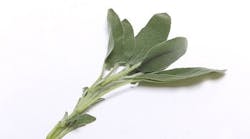Basil
Numerous patches of ground are devoted to culinary herbs that characterize different cuisines. Sage, oregano, rosemary — dozens of fragrant plants with the mere touch of a leaf will infuse the surroundings with their aromatic signature.
“We field a lot of questions about herbs and health from a variety of sources,” acknowledges Mark Blumenthal, founder and executive director of the American Botanical Council, a non-profit think tank and educational organization on herbs and their application in Austin, Texas. “From health practitioners to interested consumers to processors doing research for products — even poison control — all want to know something about herbs.”
For the food and beverage processor, botanical herbs, spices and other plant ingredients (such as roots, tubers and rhizomes) fall into two important categories: GRAS (generally regarded as safe), or not. But it’s important to note that a GRAS rating only applies to food additives, not to the practice of herbal medicine.
Botanical ingredients in foods provide flavor, aroma and often color. Of significant added value, however, is a distinct health component in the form of a veritable library of phytochemicals, food elements that, while falling short of being considered essential nutrients, have been shown through millennia of anecdotal and ethnographic evidence and scientific research to contribute greatly to prevention of disease and alleviation of symptoms of various diseases and conditions.
Sage
An update on the science behind the mechanisms of how some of the most popular and widely used herbs function, “Recent Advances in Biologically Active Compounds in Herbs and Spices: A Review of the Most Effective Antioxidant and Anti-Inflammatory Active Principles,” was recently published in Critical Reviews in Food Science and Nutrition. The review described how researchers are taking a new look at the method by which familiar herbs aid in disease prevention.
According to the review, most studies have focused on the antioxidant properties of various herbs and spices. An extensive database titled “The total antioxidant content of more than 3100 foods, beverages, spices, herbs and supplements used worldwide” and released in Nutrition Journal by Carlsen, et alia, revealed that the most potent sources of phytochemicals are found in herbs and spices (as opposed to most fruits and vegetables).
Reactive oxygen species (ROS), toxic oxygen compounds called “free radicals” that are normal byproducts of both plant and animal metabolism, are considered the major contributors to many of the diseases associated with aging, including cardiovascular diseases, cancer, cataracts, age-related decline in the immune system and even degenerative diseases of the nervous system, such as Parkinson’s and Alzheimer’s. ROS have the potential to damage lipids in membranes, as well as proteins, DNA and other molecules critical to cellular structure and function. The body’s innate defenses include a variety of endogenous antioxidants that require dietary support from antioxidants found in many plants. Plant-derived antioxidant compounds can either counter ROS directly or help to restore natural antioxidant capacity.
Phyto Power
Many of the active compounds in botanicals known for their antioxidant potential are of a class called polyphenols. However, protection from free radical damage has not been sufficient to account for all of the anti-inflammatory, anti-tumor and anti-atherogenic effects associated with some of these traditional plants. Recent studies indicate these active components also influence the cell-signaling pathways activated during inflammation. They are even believed to act as cell-signaling agents of their own accord.
Rosemary
The most recent polyphenols isolated from herbs and spices include terpenes such as thymol and carvacrol. These are found in oregano and thyme. The compounds seem to inhibit the oxidation of low density lipoproteins (LDL), the undesirable cholesterol. They also might reduce inflammation by inhibiting LDLs from stimulating pro-inflammatory chemicals produced by the immune system.
Carnosic acid, carnosol, rosmaridiphenol and rosmanol found in rosemary and sage protect membranes from damage and reduce inflammation by inhibiting formation of pro-inflammatory compounds. Hidroxycinnamic acids and their derivatives, including caffeic acid found in sage, parsley, thyme and oregano, as well as ferulic acid present in mint may also inhibit oxidation of LDLs. Rosmarinic acid, found in rosemary, thyme, mint, sage, basil and oregano, inhibits inflammatory proteins of the immune system. Curcumin, the active compound found in turmeric serves as both an anti-inflammatory and a powerful antioxidant. It reduces COX-2 and other pro-inflammatory proteins while increasing the production of endogenous antioxidants.
Flavonoids are found in lower concentrations in herbs and spices than polyphenols, but they, too, are powerful antioxidants. Quercetin from dill has been determined in laboratory experiments to inhibit inflammation via the COX-2 pathway, and to decrease C-reactive protein, a marker for inflammation. Other powerful flavonoids include luteolin from thyme and mint, thought to reduce total and LDL cholesterol while increasing the more desired HDL cholesterol, and apigenin, found in parsley, also inhibit inflammatory signaling proteins.
It’s important to note that randomized controlled trials on the intake of single isolated antioxidants have failed to fully demonstrate health benefits promised by use of the whole herbs and spices. Botanical ingredients are complex substances whose subtle organoleptic contributions to a variety of traditional cuisines, as well as other food and beverage products, are reinforced by their health potential. But as a part of the whole diet, herbs and spices work in synergy to help promote health and well-being.


